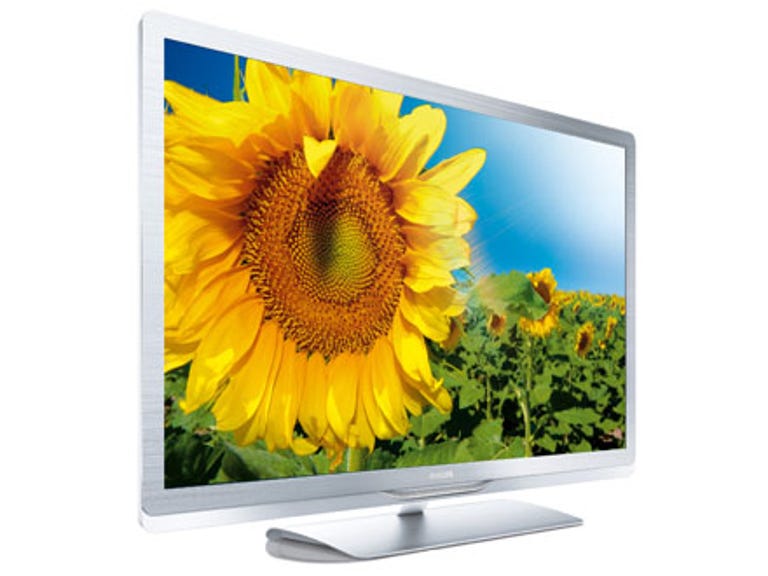 Why You Can Trust CNET
Why You Can Trust CNET Philips Econova 6000 (42PFL6805H) review: Philips Econova 6000 (42PFL6805H)
The 42-inch Philips Econovo 42PFL6805H is very expensive and lacks some important features, but it is also kinder to the environment than most TVs, looks great and has very good picture quality.
Philips reckons the Econova 42PFL6805H is the most eco-friendly set currently available, but being kind to the environment will cost you -- this TV is priced at £1,200, which is quite steep for a 42-incher.
The Good
The Bad
The Bottom Line
Green screen
The TV shows its green credentials in a number of key ways. Its packaging doesn't use any polystyrene or plastic. Instead, the TV is packed up in the box using recycled cardboard spacers and even the extras, like the remote, are provided in small paper bags.
Perhaps more importantly, the TV's chassis and stand are made from recycled aluminium. LED backlighting is now common on high-end sets, but the backlighting used here is able to bring the power consumption down to as low as 40W when running in eco mode -- almost half that of many of its competitors. Even the remote has had the once-over -- it has a solar panel on the bottom, so if you rest it on a table upside down it'll gradually recharge itself.

If you think recycled aluminium doesn't sound like a recipe for an attractive telly, be prepared to be surprised, because this really is a great-looking set. The chassis is made from a single aluminium plate, and the brushed effect looks very classy. It's supremely slim, too, measuring a mere 43mm deep. Cleverly, the stand can also be removed and reattached vertically to the rear of the set to act as a wall mount, saving further waste.
Little compromises
Philips hasn't compromised when it comes to the range of ports on offer, either. The Econova boasts a full complement of four HDMI sockets, a set of component inputs, two Scart sockets and VGA input. There's also a USB port that you can use for playing back digital pictures, MP3 music files and videos in DivX and MKV formats.
Philips has some of the best picture-processing technology around. Although this TV makes do with the Pixel Precise HD engine, rather than the more advanced Perfect Pixel HD found on the company's 9000-series TVs, it does pack in HD Natural Motion alongside 100Hz processing.
Natural picture
The set is at its best when dealing with high-definition sources. Watching BBC HD via a Sky HD box or movies such as Wolverine on Blu-ray, the set delivered impressively rich and vibrant colours, and pretty deep black levels, too. Sharpness is also impressive and motion looks very smooth, although you have to be careful with the HD Natural Motion settings if you don't want movies to take on a flatter, camcorder look.
Standard-definition channels from the set's Freeview tuner don't look nearly as good as they do on similarly sized and priced sets from the likes of Sony and Panasonic. Freeview pictures tend to look a little noisy even with Pixel Precise HD's MPEG noise-reduction turned on.
Naturally, when running the TV in its energy-saving mode, brightness is reduced substantially. In a well-lit room, this mode probably overdoes it a little. That said, if you prefer to watch movies with the lights turned down, you'll find the reduced brightness of the energy-saving mode actually helps the set to deliver even deeper black levels. The eco mode is really power-efficient, too -- our power meter showed it running at around 45W compared to around 75W in the cinema mode.
Sounds eco-friendly
Philips' high-end TVs are generally some of the best around when it comes to audio performance, mainly because they have a subwoofer built into the rear of the chassis. The Econova includes a mini sub on the rear, too, and as a result manages to deliver fuller audio than most of the sets from other manufacturers.
Nevertheless, there are still a fair few negatives with this TV. As with many of Philips' higher-end sets, in an attempt to make the menu system more straightforward to use, Philips has actually needlessly overcomplicated things. As a result, simple stuff, like checking the programme info for a show you're watching, takes multiple button presses on the remote, rather than just one. Also, although the Pixel Precise HD engine produces good results, it's quite tricky to use and is likely to baffle those of a non-technical bent.
Despite the TV's very high price tag, it also misses out a few features that you'll find on rival TVs and even some of Philips' own models. It lacks the Ambilight feature that makes many of Philips' high-end TVs so appealing (although this has been removed to make it more eco-friendly). Frustratingly, it also lacks a Freeview HD tuner, so you're stuck with a standard-definition one instead. There's no Wi-Fi or Ethernet on board, either, so you don't have access to online services such as the BBC iPlayer, YouTube or Lovefilm like you do on models from Sony and Panasonic.
Conclusion
Overall, there's much to like about the Philips Econova 42PFL6805. It's kinder to the environment than many TVs, yet it looks supremely stylish and delivers very good picture quality. It's just a shame that saving the planet has such a high price tag, and means you miss out on features like HD tuners and support for Internet services.
Edited by Emma Bayly


